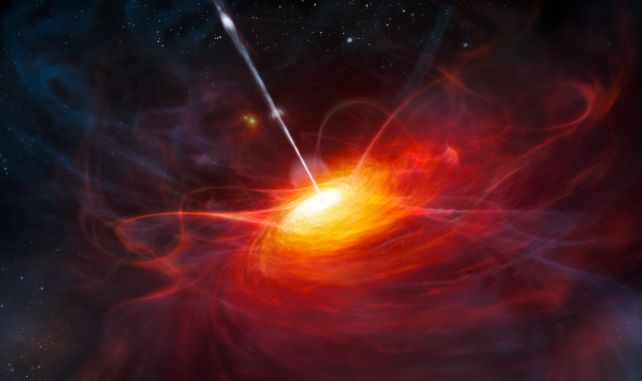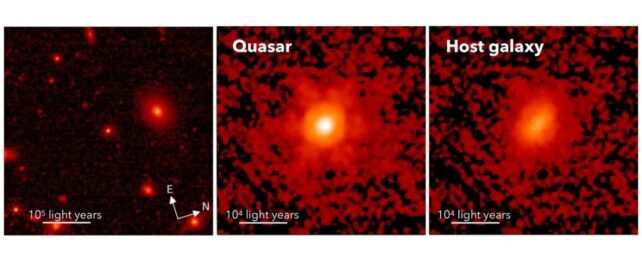For the first time, starlight has been detected in galaxies burning brightly with the fury of feeding black holes in the first billion years of the Universe's existence.
It stands to reason that these active supermassive black holes – known as quasars – would have galaxies around them. But stretched over such great distances, any starlight within them has previously been impossible to detect, leaving astronomers questioning how such monstrous objects form and grow in such a short space of time.
Now, with combined data from the Subaru Telescope in Hawaii and the James Webb Space Telescope, a large international team has been able to probe two quasar galaxies in the early Universe to learn more about this mysterious time in the history of everything.
The research was led by astrophysicists Xuheng Ding and John Silverman of the Kavli Institute for the Physics and Mathematics of the Universe (Kavli IPMU) in Japan and Masafusa Onoue of the Kavli Institute for Astronomy and Astrophysics in China.
"This is the first time we've seen host galaxies from such an early age of the Universe. It is only possible thanks to JWST's deep images, which enable us to model and subtract the light from the quasar to reveal the host galaxy," explains astronomer Chien-Hsiu Lee of the W. M. Keck Observatory.
"We've seen quasars from this age previously, but they were so bright it was impossible to subtract their light to reveal the host galaxy."

Black holes themselves don't emit any light that we can currently detect. They're famous for it, in fact.
But an active black hole is a slightly different matter. Well, not the black hole; that's still about as dark as darkness gets. It's what's happening in the space around it. An active black hole is one that has enough material in its vicinity to feed. That material swirls around the black hole, heated to millions of degrees by friction and gravity so it lights up across the electromagnetic spectrum.
There's so much material swirling around in a quasar that it positively blazes across the eons of space-time. That's how we can see them glowing in the Cosmic Dawn, the period covering the first billion years after the Big Bang. Even there, they are still relatively faint; you'd never see a Cosmic Dawn quasar with the naked eye or a backyard telescope, but in recent years our powerful telescopes have been finding them in increasing numbers.
This has raised all sorts of questions, such as: how do we get supermassive black holes so big, so soon after the Big Bang? What are their galactic environments like? We're still a little lost on the first question, but we're finally getting answers on the second.
The two quasar galaxies in question are called HSC J2236+0032 and HSC J2255+0251, and we're observing them roughly 860 million years after the Big Bang. They were found in a survey taken using Subaru, with JWST being called in to study them in closer detail.
The supermassive black holes at the centers of these two quasar galaxies are 1.4 billion and 200 million times the mass of the Sun, respectively. This allows constraints to be placed on the amount of light generated by the black hole activity, since there's a limit to the rate at which a black hole can feed.
The researchers subtracted this light from the JWST observations, which left them with the light generated by the host galaxies: the light of their stars, shining.
Even more than this, though, the light of the galaxies enabled the researchers to calculate the masses of the galaxies – 130 billion and 30 billion solar masses, respectively.
This is important because it tells us something we didn't know about early Universe galaxies. The masses of supermassive black holes and their galaxies in the nearby Universe are linked. If you know the mass of a black hole, the mass of a galaxy around it can be predicted, and vice versa, even for small galaxies.
We're not sure why this is, whether it's some property of the black hole that limits the growth of galaxies past a certain point, or whether galaxies and supermassive black holes grow together, but finding black holes in the early Universe might give us some clues.
J2236+0032 and J2255+0251 both were consistent with this mass ratio between a supermassive black hole and its galaxy. This suggests that this relationship was already in place when the first supermassive black holes were born. And it gives astronomers a new datapoint to work in while modeling early Universe evolution to understand how things unfolded during the Cosmic Dawn.
Whether or not it is true for all early Universe galaxies remains to be investigated. Two galaxies is not a tremendously large sample, so the researchers will be going back for more. They have booked more observing time with JWST, and hope to learn more about how the first galaxies formed.
"Ongoing JWST observations will give us a significantly larger sample," they write in their paper, "allowing us to better constrain models for the mutual evolution of the black hole and stellar populations in galaxies."
The research has been published in Nature.
